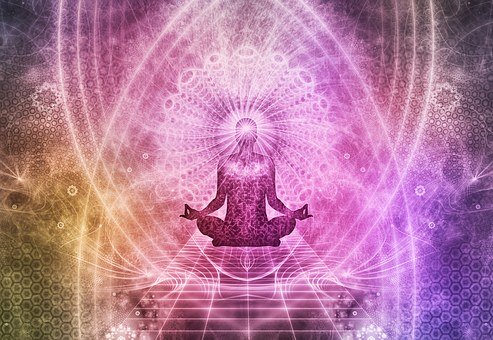Edited by Sudiipa Mara Grandinetti

When we speak of humanity we inevitably find ourselves taking into account the different cultural and religious manifestations that are expressed within it.
Although the human soul, mind and body are subjected to common universal laws, the different traditions developed over the centuries and millennia have led to the formation of opposing spiritual and religious thoughts. In the case of yoga, when understood in its most authentic sense, this multitude of differences vanishes and allows everyone to practice and obtain the results that the discipline has brought since millennia.
Yoga means the union of the individual self with the Universal Self, where “Universal Self” means the deepest part of the being, which we can reach when the individual thinks of Infinity. When this happens, the mental substance expands and automatically and gradually becomes infinite.
From this point of view no creed can be excluded, since the Entity that unites all Beings, the Infinite Cosmic Consciousness, is the aspect towards which all seekers move. Every religion pictures this Entity in its own way, some with forms, some with names, some with adjectives, trying to guide the individual mind towards that form of Consciousness whose existence we can perceive, but whose description is always very difficult.Even atheists can benefit from the practices of yoga, based on its evident psycho-physical benefits, and the calmness of mind engendered by proper meditation. Ultimately they may come to the natural conclusion that the divinity they deny is none other than the Reality that they accept.
Creating a relationship without quarrels between Yoga and the various religions is not always easy. Institutions or representatives of one creed or another often still condemn the practice of yoga and consider it incompatible with their own religion.
An example of this is given by the recent case of some Islamic groups in Nepal, the first country in the world to have introduced yoga as a compulsory subject in primary and secondary schools since the spring of 2020. According to the New York Times, the singing of the Om and the Sun Salutation are some of the disputed aspects, which seem to clash with Islamic monotheism.

At the same time, the principles and practice of yoga and meditation may be seen as the scientific, physiologic and psychological basis for most religions. Most Yogic disciplines prefer to follow a logical path, forbidding its practitioners from attacking people’s religious sentiments. In fact, Ananda Marga guidelines say that attacking somone else’s religious sentiment would be an attack on Ananda Marga. Other yogic paths like Integral Yoga of Shrii Swami Satchidananda and Self-Realization Fellowship of Paramahansa Yogananda have similar tolerant approaches and even have pictures of various gurus and religious figures prominently displayed in their temples.
With respect to theadvent of local deities, Shrii Shrii Anandamurti, spiritual Gurudev of the Ananda Marga Yoga Society, explores in an interesting way some biopsychological and scientific aspects of human nature that over the millennia have been transformed into icons and deities. (1) These icons and deities seem to personify concepts and knowledge that may have been too complex to be understood by ordinary people. By relating to an anthropomorphic figure, people could relate better to the emotion or talent or tendency attributed to the deity.
We find many similarities between the various religions and yoga practice. For instance, the Jewish religion, as taught in the Torah, includes washing practices, control of diet, respect for elders, and a moral code known as the Ten Commandments which are very similar to Yama and Niyama as taught by Patanjali and further elucidated by Anandamurtiji (2) and others. The Christian religion has at its base a Guru figure with divine attributes known as Jesus Christ. He taught love for all beings, and service to all while recognizing that the impoverished person who is being served can be looked upon as Jesus himself. This is similar to the notions of Tapah and Brahmacarya, wherein one takes the ideation of the Supreme while rendering selfless service or seva. Islam focuses on doing the will of God and performing charitable acts, and emphasizes the witnessing quality of Allah in all things. This is similar to the yogic concepts of Iishvara Pranidhana, and with Purusha witnessing this entire universe, and the encouragement of doing karma yoga to help ensconce oneself in that Cosmic Consciousness. The washing practices of the Muslims and the bowing of Namaj are also practiced by yogis. And of course Hinduism has as much of its basis the Tantric teachings of Shiva and the yogic teachings of Krsna in the Bhagavad Gita. Finally, we recognize that the summum bonum of yoga practice is the ecstatic merger of the mind in the Cosmic, and this is recognized also by the mystical adherents of all the religions, like the Jewish Kabalists, the Sufis, and the Rosicrucians.
Authors of the article: Bhavanii Valentina Polo – Yoga Teacher based in Italy, inspired by traditional yogic teachings – Contacts: [email protected]
Rainjiita Raffaella Simonetti – Yoga Teacher for children – Contacts: [email protected]
Dr. Pashupati Steven Landau MD – Family practitioner of allopathic and holistic medicine, Acarya of Ananda Marga, Yoga Teacher trainer – Greensboro, North Carolina, USA [email protected]
Editor: Sudiipa Mara Grandinetti is an Ayurvedic therapist, Yoga educator, MD and founder of Anima Yoga & Ayurveda Center in South Tyrol, Italy – Contacts: [email protected]

